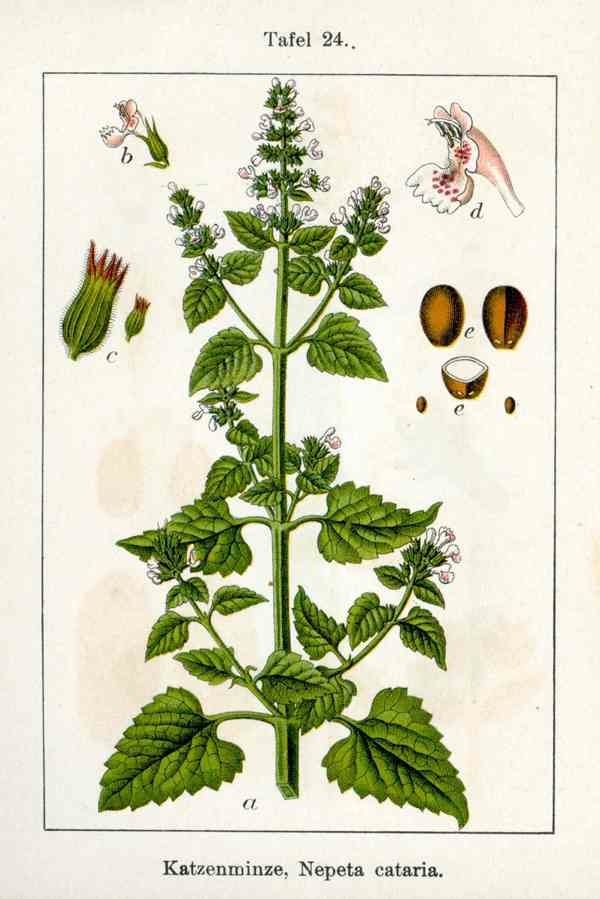 Also Known As:
Also Known As:
Cataire, Catmint, Catswort, Chataire, Field Balm, Hierba Gatera, Menta de Gato,
Menthe des Chats.
CAUTION: See separate listing for Schizonepeta.
Scientific Name:
Nepeta cataria.
Family: Lamiaceae/Labiatae.
People Use This For:
Catnip is used for insomnia; migraine headaches; cold; flu; swine flu; fever;
hives; and gastrointestinal (GI) upset, including indigestion, colic, cramping, and
flatulence. It is also used orally for conditions associated with anxiety, diuresis,
as a tonic, for upper respiratory tract infections, and headaches. Additionally,
catnip is also used orally for lung and uterine congestion, eradicating worms, and
for initiating menses in girls with delayed onset of menstruation.
Topically, catnip has been used for arthritis, hemorrhoids, and as a poultice to
relieve swelling.
As an inhalant, catnip is smoked for respiratory conditions and recreationally for
inducing a euphoric high.
In manufacturing, catnip is used as a pesticide and insecticide.
Safety:
POSSIBLY SAFE ...when used orally and appropriately (2,3). Significant adverse
effects have not been reported when catnip tea is used in cupful amounts (62).
POSSIBLY UNSAFE : when used orally in excessive doses. Higher doses may
be associated with significant adverse effects (62). ...when inhaled by smoking
dried leaves. Smoking the dried leaves of catnip has been associated with a
euphoric high (2), which might impair judgment; however, whether catnip can
truly produce this effect in humans remains controversial (2).
There is insufficient reliable information available about the safety of topically
applied catnip.
CHILDREN: POSSIBLY UNSAFE ...when used orally. One child developed
stomach pain and irritability followed by lethargy and hypnotic state after
ingesting catnip leaves and tea (1,5).
PREGNANCY: LIKELY UNSAFE ...when used orally. Catnip tea has been
reported to have uterine stimulant properties (3); avoid using.
LACTATION: Insufficient reliable information available; avoid using.
Effectiveness:
There is insufficient reliable information available about the effectiveness of
catnip.
Mechanism of Action:
The applicable part of catnip is the flowering tops. The pharmacological effect
that catnip is famous for is the euphoric state it induces in cats. It is thought that
the constituent cis-trans-nepetalcatone produces the characteristic stimulation
in cats only when they smell it (1). Although humans have used catnip to
induce a euphoric high, whether or not this effect actually occurs in humans
is controversial. In humans, the constituent nepetalactone is thought to be
responsible for catnip's calming effects in insomnia, anxiety, gastrointestinal (GI)
conditions, and migraine headache. Nepetalactone is the major component (80-
95%) of the volatile oil of catnip and is structurally related to the valepotriates
found in valerian. Catnip provides approximately 0.2-1% volatile oil. Catnip
reportedly also has antipyretic and diaphoretic effects, which have been
attributed to its use for colds, flu, and fever. Other reported pharmacological
effects, include diuretic and stimulation of gallbladder activity (2).
Adverse Reactions:
Report an Adverse Reaction to CATNIP
Catnip abuse may result in headache and malaise. Large amounts of tea may
cause vomiting (2). One case report exists of a nineteen-month-old child who
developed a stomachache and irritability, followed by lethargy and a hypnotic
state after ingesting raisins soaked in catnip tea and chewing on the tea bag (5).
Interactions with Herbs & Supplements:
HERBS AND SUPPLEMENTS WITH SEDATIVE PROPERTIES: Theoretically,
concomitant use of catnip with herbs that have sedative properties might
enhance therapeutic and adverse effects. Some of these supplements include
5-HTP, calamus, California poppy, catnip, hops, Jamaican dogwood, kava, St.
John's wort, skullcap, valerian, yerba mansa, and others.
Interactions with Drugs:
CNS DEPRESSANTS <<interacts with>> CATNIP
Interaction Rating = Moderate Be cautious with this combination.
Severity = High • Occurrence = Possible • Level of Evidence = D
Theoretically, concomitant use with drugs with sedative properties may cause
additive effects and side effects (4).
LITHIUM <<interacts with>> CATNIP
Interaction Rating = Moderate Be cautious with this combination.
Severity = Moderate • Occurrence = Probable • Level of Evidence = D
Catnip is thought to have diuretic properties. Theoretically, due to these potential
diuretic effects, catnip might reduce excretion and increase levels of lithium. The
dose of lithium might need to be decreased.
Interactions with Foods:
None known.
Interactions with Lab Tests:
None known.
Interactions with Diseases or Conditions:
PELVIC INFLAMMATORY DISEASE (PID) and MENORRHAGIA: Because
catnip is also used to stimulate menstruation, theoretically it is contraindicated in
pelvic inflammatory disease (PID) and excessive menstrual bleeding (3).
SURGERY: Catnip has CNS depressant effects. Theoretically, catnip might
cause additive CNS depression when combined with anesthesia and other
medications during and after surgical procedures. Tell patients to discontinue
catnip at least 2 weeks before elective surgical procedures.
Dosage/Administration:
ORAL: People typically use two 380 mg capsules three times daily at meals or
prepared as a tea using 1-2 teaspoons in 6 ounces of boiling water.
Specific References: Catmint
1. Foster S, Tyler VE. Tyler's Honest Herbal: A Sensible Guide to the Use of
Herbs and Related Remedies. 3rd ed., Binghamton, NY: Haworth Herbal Press,
1993.
2. The Review of Natural Products by Facts and Comparisons. St. Louis, MO:
Wolters Kluwer Co., 1999.
3. McGuffin M, Hobbs C, Upton R, Goldberg A, eds. American Herbal Products
Association's Botanical Safety Handbook. Boca Raton, FL: CRC Press, LLC
1997.
4. Brinker F. Herb Contraindications and Drug Interactions. 2nd ed. Sandy, OR:
Eclectic Medical Publications, 1998.
5. Osterhoudt KC, Lee SK, Callahan JM, Henretig FM. Catnip and the alteration
of human consciousness. Vet Hum Toxicol 1997;39:373-5.